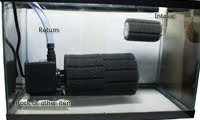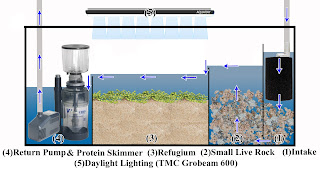SPONGE FILTERS
From
"Sponge Filtration"
The use of Sponge Filters in aquariums and ponds is often overlooked by newer aquarium/pond keepers.
What many see as an overly simple filter, is in fact a near "perfect" design in its simplicity.
I have used them for my aquarium maintenance for 30 plus years with excellent results, including: Main Filter, secondary filter, pre-filter, hospital filter, and bowl or small tank filter (Sponge filters really excel here for bettas in that they are efficient bio and mechanical filters without the risk of fin damage to bettas).
Here then is a list of their basic attributes:
[1] Simple to use, most run on very basic
air pumps or
powerheads. One of the best beginner aquarist filters due simplicity and cost. But sponge filters are also popular with breeders and research facilities, as they are very efficient yet simple filters.
[2] Excellent biological filtration, they are very porous and can maintain very large aerobic bacterial colonies in proportion to the space they occupy.
[3] Mechanical filtration, although they are not the best mechanical filters, they still do a good job for their small size and make excellent secondary or primary filters when used in combination with other filters such as
HOB, canister, or internal filters.
[4] Very few “dead” areas trapping pockets of noxious bacteria, unlike under gravel filters and even wet/dry filters (which in my experience are over rated).
[5] Simple to clean, simply remove the sponge and squeeze or rinse in old aquarium water or de-chlorinated tap water. The advantage here is the aquarist is less likely to ignore cleaning the filter (unlike many complex filters), which can lead to organic build up, increasing nitrates and lowering KH and ph.
[6] Sponge filters are great in marine aquariums in a couple of different ways; one way is in a sump (sometimes sideways) with a small power head pump (such as a Via Aqua 480); the other (usually in a reef application) was inside the aquarium with either an air pump or power head. The beauty of either application is they are simple to rinse out with used aquarium water, which in the reef application was especially useful in that I could dispose of allot of debris before it cycled and produced Nitrates. They are an excellent compliment to “live rock” filtered reef aquariums.
[7] Probably the best choice of filtration for breeding tanks, hospital tanks, and even discus aquariums, due to the fact that they do not “suck” in baby or weak fish or attract noxious bacteria.
[8] For cichlid breeding they excel, as they are not easily disturbed by cichlids tendency to dig.
[9] Inexpensive
[10] Now available in larger sizes for aquariums over 60 gallons.
[11] Sponge filters can even be used in ponds. With the
"Hydro Pond Filter", simply attach a power head pump (such as a Via Aqua 2600), then run your return line wherever you like (waterfall, etc.). Or the Hydro Pond II can be run off a simple air pump. These filters can work on ponds up to 1500 gallons (or more with additional units).
These Hydro Pond filters also work VERY well in large aquariums especially as a pre-filter (#4) for pump in an aquarium sump for wet/dry or Berlin Method Marine filtration.
[12] There also are sponge filters that are used as a
"Pre-Filter" for intakes of canister, wet/dry, power filters and more. They offer increased bio-filtration to your existing system, as well as protection from baby fish, plants, or anemones from being sucked into the intake of your existing filter.
These pre-filter sponges are especially useful for HOB (power filters) as they increase the bio capacity (far more than bio wheels in experiments I have done) and retain the aerobic bio filtering bacteria during filter media changes. With out these Sponge pre-filters, HOB filters are poor to fair bio filters, with them they are excellent.
[13] Sponge filters are great for planted aquariums, they do not interfere with root structures and maintain a biological balance that ideal for planted aquariums.
[14] EXCELLENT for use in marine aquariums, especially when the Berlin Filter method is applied. I have used these as a pre-filter for the return pump for a Mud filter, in a sump, or as just an additional bio/mechanical filter inside a Nano Reef. The advantage of these in marine applications is they trap debris and organic mulm which is VERY easily rinsed out unlike a more difficult canister filter or even bio balls, thus reducing the “nitrate factory” aspects of many other mechanical/bio filters in marine aquaria.
[15] Sponge filters or internal filters with sponges are very efficient for powering UV Sterilizers and Fluidized Bed filters (an under rated but excellent filter on its own).
Here are a few myths about Sponge filters:
* Bio Wheels and
Wet Dry filters are superior to sponge filters.- MYTH
In theory the added oxygen or bio wheels and wet dry filters is great, but in practicality the channeling of wet dry filters and the deposit build up of Bio Wheels lowers bacteria surface area, while the fact remains that with the proper dissolved oxygen levels your fish should have is more than adequate for a healthy sponge filter to maintain proper bio colonies. Compare a Wet Dry filter to a tank with live rock and other means of mechanical filtration, and you will find the live rock superior even though it is under water.
* All sponge filters are the same and only for small aquariums. –MYTH
The flow design, sponge media material, and sponge size all are important. A large sponge filter with sponge media of a high and proper sized pore count is and extremely efficient filter. Compare the sponge design of the patented Hydro Sponge to a cheaper Lees or Tetra sponge and it is obvious, as these cheaper sponges clog faster and do not have the pore density of Hydro Sponge filters.
FOR EVEN MORE INFORMATION ABOUT SPONGE FILTRATION, please visit this site:

AQUARIUM SPONGE FILTRATION AND HOW IT WORKS
OTHER INTERESTING LINKS

Aquarium Sponge Filters A GREAT PLACE FOR QUALITY ATI HYDRO SPONGE FILTERS, Prices starting at $5.99!
The importance of aquarium water qualityBasic information about freshwater or marine water quality maintenance.
Labels: Aquarium Filter, Aquarium Sponge filters, Planted Aquarium, Pond, Sponge Filter Attributes, Sponge Filter Information
 While not at all a new idea, it is often a forgotten idea that is especially useful for Breeder Aquariums & Goldfish Aquariums (especially bare bottom tanks)
While not at all a new idea, it is often a forgotten idea that is especially useful for Breeder Aquariums & Goldfish Aquariums (especially bare bottom tanks) The second picture displays the Hydro Sponge #5 Stackable which can be used in large breeder tanks, but is best to add on to large high bio load aquariums.
The second picture displays the Hydro Sponge #5 Stackable which can be used in large breeder tanks, but is best to add on to large high bio load aquariums.




















 POND SPONGE FILTERS
POND SPONGE FILTERS FILTER MAX SPONGE PRE-FILTER
FILTER MAX SPONGE PRE-FILTER Rio Internal Filter
Rio Internal Filter EVERYTHING AQUATIC
EVERYTHING AQUATIC